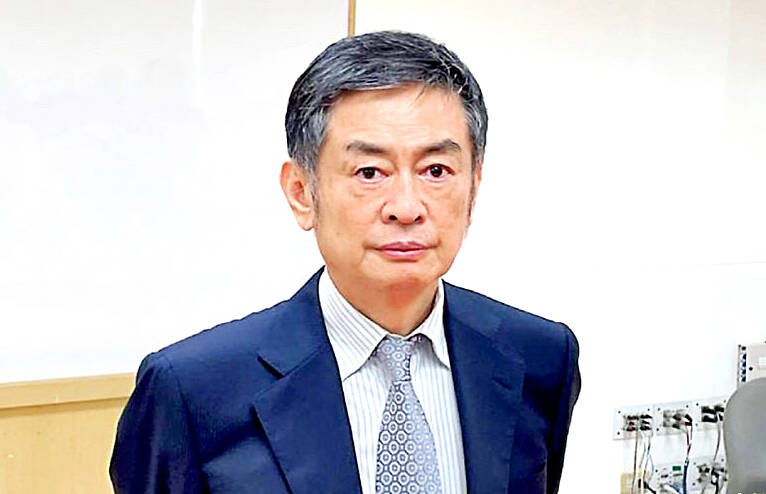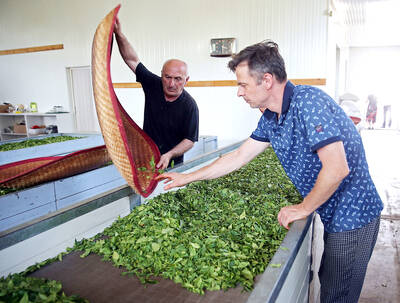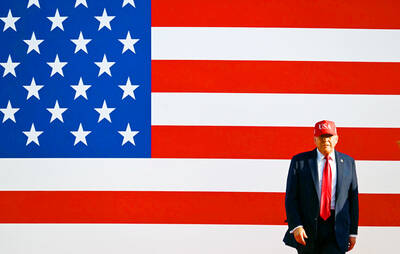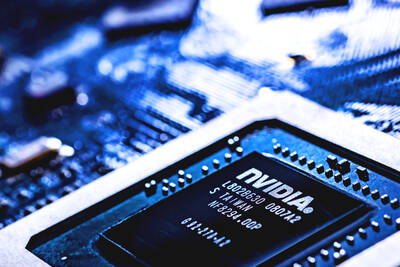Largan Precision Co (大立光), a major camera lens supplier for Apple Inc’s iPhones, yesterday reported record profit for last quarter and predicted revenue in the first two months of this year would surpass the figure in the correspondent period of last year.
The Taichung-based company also said it has tapped into the humanoid service robot market and started delivering plastic camera lens samples to multiple customers.
The company is designing camera lenses for collaborative robots, mostly robotic arms deployed in factories, Largan chief executive officer Adam Lin (林恩平) told investors.

Photo: Ou Yu-hsiang, Taipei Times
“This is new. The specifications for humanoid robots are lower than those [camera lenses] used in smartphones currently, but it is unclear how the spec will vary in the future,” Lin said. “The visualization of a humanoid robot requires at least two camera lenses for a humanoid robot to have vision to avoid collision and have night vision.”
During the final quarter of last year, net profit soared to NT$8.68 billion (US$263.6 million), almost doubling from NT$4.97 billion a year earlier, Largan said. That represented a sequential growth of 31 percent from NT$6.63 billion.
Largan attributed the growth to extra bonuses granted by major customers, rewarding the company’s strong shipment performance based on a two-year agreement.
“We have been receiving bonuses from customers usually for minor projects, so the amount did not stand out. It never happened to major projects before,” Lin said. “We have secured new agreements with customers for 2025. We may receive bonuses if we hit the shipment target set by customers.”
Last year as a whole, Largan’s net profit surged 45 percent year-on-year to NT$25.92 billion from NT$17.9 billion in 2023. Earnings per share jumped to NT$194.17 from NT$134.13 in 2023, the highest level since 2019.
Gross margin climbed to 59 percent last quarter, compared with 50.24 percent the previous quarter and 52.8 percent a year earlier, on the back of better product mix, the company said.
Lenses with a resolution of 20 megapixels or greater — a higher-margin product and one of Largan’s specialties — accounted for 20 to 30 percent of the company’s shipments last quarter, higher than the 10 to 20 percent in the previous quarter.
Ten megapixel lenses made up 60 to 70 percent of shipments last quarter, unchanged from a quarter earlier. Eight megapixel lenses comprised about 10 percent, the same as the third quarter last year. Other products such as coil motors contributed a lower portion of 10 percent of total shipments, versus 20 to 30 percent in the third quarter last year, the company said.
However, Largan said gross margin would not reach such high level again in the foreseeable future.
Largan spent NT$10.7 billion on new facilities and manufacturing equipment last year, with depreciation costs amounting to NT$5.8 billion, it said.

When Lika Megreladze was a child, life in her native western Georgian region of Guria revolved around tea. Her mother worked for decades as a scientist at the Soviet Union’s Institute of Tea and Subtropical Crops in the village of Anaseuli, Georgia, perfecting cultivation methods for a Georgian tea industry that supplied the bulk of the vast communist state’s brews. “When I was a child, this was only my mum’s workplace. Only later I realized that it was something big,” she said. Now, the institute lies abandoned. Yellowed papers are strewn around its decaying corridors, and a statue of Soviet founder Vladimir Lenin

UNIFYING OPPOSITION: Numerous companies have registered complaints over the potential levies, bringing together rival automakers in voicing their reservations US President Donald Trump is readying plans for industry-specific tariffs to kick in alongside his country-by-country duties in two weeks, ramping up his push to reshape the US’ standing in the global trading system by penalizing purchases from abroad. Administration officials could release details of Trump’s planned 50 percent duty on copper in the days before they are set to take effect on Friday next week, a person familiar with the matter said. That is the same date Trump’s “reciprocal” levies on products from more than 100 nations are slated to begin. Trump on Tuesday said that he is likely to impose tariffs

HELPING HAND: Approving the sale of H20s could give China the edge it needs to capture market share and become the global standard, a US representative said The US President Donald Trump administration’s decision allowing Nvidia Corp to resume shipments of its H20 artificial intelligence (AI) chips to China risks bolstering Beijing’s military capabilities and expanding its capacity to compete with the US, the head of the US House Select Committee on Strategic Competition Between the United States and the Chinese Communist Party said. “The H20, which is a cost-effective and powerful AI inference chip, far surpasses China’s indigenous capability and would therefore provide a substantial increase to China’s AI development,” committee chairman John Moolenaar, a Michigan Republican, said on Friday in a letter to US Secretary of

Taiwan Semiconductor Manufacturing Co’s (TSMC, 台積電) market value closed above US$1 trillion for the first time in Taipei last week, with a raised sales forecast driven by robust artificial intelligence (AI) demand. TSMC saw its Taiwanese shares climb to a record high on Friday, a near 50 percent rise from an April low. That has made it the first Asian stock worth more than US$1 trillion, since PetroChina Co (中國石油天然氣) briefly reached the milestone in 2007. As investors turned calm after their aggressive buying on Friday, amid optimism over the chipmaker’s business outlook, TSMC lost 0.43 percent to close at NT$1,150